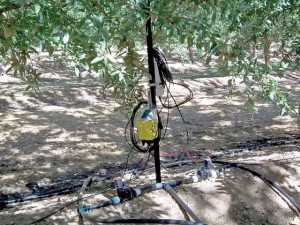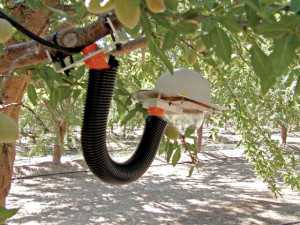Managing Water Use With Precision Irrigation

The wireless node and controller is a part of a sensor suite that helps detect and continuously monitor the plant’s water status and allow the growers and researchers to decide when to irrigate. (Photo credit: Michael Delwiche)
Water is becoming an increasingly scarce resource, and as the demand to do more with less in the orchard grows, researchers at the University of California (UC)-Davis are spearheading a USDA-Specialty Crop Research Initiative (SCRI) project to address how plants absorb water and when it is an appropriate time to irrigate. The research project involves several components (see “More Than Just Irrigation”) and several universities.
Shrini Upadhyaya, professor in the Department of Biological and Agricultural Engineering at UC-Davis, says water is of great concern to almond growers.
“Irrigation is so critical to grow. It’s a $13.2 billion industry, just the fruits and the nuts,” said Upadhyaya, who is the director of the precision canopy and water management project. “In the valley where we grow these crops, we don’t get a single drop of rain, generally speaking, during the growing period.”
Monitoring The Plant’s Water Status
Upadhyaya, along with a team of researchers, are seeking to sense and monitor the plant’s water status and how to effectively control irrigation based on the plant’s stress level. Some growers use soil moisture sensors to determine whether there is a need for irrigation. But there are limitations with this approach, as Upadhyaya and Michael Delwiche, a professor in the same department at UC-Davis, point out.
“The problem with the soil moisture sensors is that they are not necessarily where the roots are,” said Delwiche, who is a research team member in the irrigation portion of the SCRI project. “Just because you’re measuring soil moisture, it doesn’t necessarily tell you the water status of the plant.”
The irrigation and monitoring of the plant’s stress level is done through a wireless network. If there is water stress on the plant, the stomata closes and the difference in temperature between the leaf and ambient decreases. This concept can be used to determine if the plant is well-watered. However, wind speed, air temperature, light level, and relative humidity also factor into how much cooling a plant experiences. The need for the wireless network was driven by convenience to the grower as well as a need for a continual stream of information.
“When we use both the handheld and the bigger mobile sensor suite, developed at UC-Davis to determine plant water status, what we see in the beginning of the season isn’t exactly what’s happening at the end of the season,” said Upadhyaya. “As the season progresses, plants seem to respond differently, and that aspect cannot be caught very well by these handheld or mobile devices. But if you have a continuous monitoring system, then we can see any changes that happen.”

A leaf monitor mounted on an almond tree continuously monitors the water status of an almond tree. The leaf monitor has a provisional patent with UC-Davis. (Photo credit: Jed Roach)
Optimizing Water Use
Researchers hope to take the plant’s water status and then apply the necessary water when the plant needs it with different irrigation levels in each block, depending upon the plant’s needs.
“What you’re trying to do is optimize water use. You’re trying to get the most value for the water input,” said Delwiche.
The precision irrigation project is part of a larger push toward precision agriculture, says Delwiche. “There are a number of different kinds of technologies that allow precision application of water,” said Delwiche. “You manage not on a field level but on a more local level and ideally, you’d go down to managing water to a single plant.”
As far as applying the technology to orchards right now, Delwiche says “There’s a lot of technology out that’s commercially available already. This network that we are using, we’ve added additional technology to allow it to turn valves on and off. A grower right now could buy the hardware,” said Delwiche. “We’re also working on a newer generation of a wireless network that would be easier to use and less expensive.”
Real Time Detection
Upadhyaya says that the research is continuing into next year in order to study the economics of adopting the technology and growers’ interest. “I hope that as a result of this project we are able to detect the plant’s stress in real time, so that a farmer, wherever he is sitting, can see the stress level and based on that, turn the water on and off,” he says. “I want to be able to demonstrate how we can use the plant water detection system to clearly identify the stress factors of the plant and how we can use it in irrigation management.”
Both Delwiche and Upadhyaya note the interest of growers in the research they’re conducting and its relevance to the future of agriculture.
“From the point of view of sustainability, given that water is a scarce resource, it was clear when I was looking at the irrigation management, supplying the right amount of water at the right time for the crop is the right thing to do,” said Upadhyaya.










